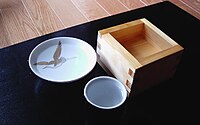
Photo from wikipedia
To valorize starchy waste from rice noodle factory, bioconversion of gelatinized starchy waste (GSW) to value-added product as L(+)-lactic acid, the monomer for polylactate synthesis, was investigated using amylolytic lactic… Click to show full abstract
To valorize starchy waste from rice noodle factory, bioconversion of gelatinized starchy waste (GSW) to value-added product as L(+)-lactic acid, the monomer for polylactate synthesis, was investigated using amylolytic lactic acid bacterium, Enterococcus faecium K-1. Screening for appropriate nitrogen source to replace expensive organic nitrogen sources revealed that corn steep liquor (CSL) was the most suitable regarding high efficacy for L(+)-LA achievement and low-cost property. The successful applying statistic experimental design, Plackett-Burman design incorporated with central composite design (CCD), predicted the maximum L(+)-LA of 93.07 g/L from the optimized medium (OM) containing 125.7 g/L GSW and 207.3 g/L CSL supplemented with CH3COONa, MgSO4, MnSO4, K2HPO4, CaCl2, (NH4)2HC6H5O7, and Tween80. Minimizing the medium cost by removal of all inorganic salts and Tween80 from OM was not an effect on L(+)-LA yield. Fermentation using the optimized medium without minerals (OM-Mi) containing only GSW (125.7 g/L) and CSL (207.3 g/L) in a 10-L fermenter was also successful. Thinning GSW with α-amylase from Lactobacillus plantarum S21 increased L(+)-LA productivity in the early stage of 24-h fermentation. Not only showing the feasible bioconversion process for GSW utilizing as a substrate for L(+)-LA production, this research also demonstrated the efficient model for industrial starchy waste valorization.
Journal Title: Applied Biochemistry and Biotechnology
Year Published: 2020
Link to full text (if available)
Share on Social Media: Sign Up to like & get
recommendations!